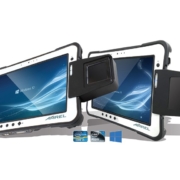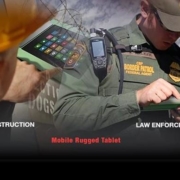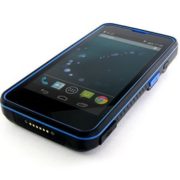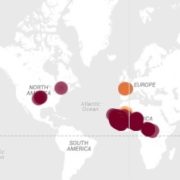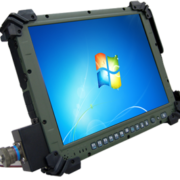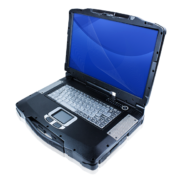LOS ANGELES (April 25, 2019) – The trusted provider of rugged biometric tablets, AMREL, announces that it will exhibit its newest integration of Suprema ID’s BM-Slim2 fingerprint sensor and optical scanner this month at Connect ID 2019, Suprema ID Booth #411. The world’s slimmest FAP20 optical sensor has been successfully integrated into AMREL’s 8-inch and 10.1-inch tablet models.
Los Angeles, CA (April 4, 2018) – AMREL, the premier provider of mobile biometric solutions and rugged computers, introduces the BioFlex® S (Gen 2), a single-finger biometric smartphone solution for security and law enforcement professionals. AMREL’s rugged BioFlex S module and Suprema ID’s BioMini Slim 2 scanner work together to convert Samsung Galaxy S7 (S8 coming soon) smartphones into biometric devices for mobile identification.
LOS ANGELES, Oct. 11, 2018 — An exceptionally versatile mobile device is now available from AMREL, the world’s premier rugged computer manufacturer. Infinitely customizable, this rugged, lightweight 8” Android tablet enables anyone to economically create highly specific detailed configurations.
AMREL will be displaying its latest and greatest at MCB Camp Pendleton on Tactical & Tech Day, Wednesday, April 22, 2015. We will be showcasing our line of super-slim, ultra-rugged laptops, handhelds, and tablets.
Special sneak peak! Come and get a look at some of our special products before they’re released to the market, including:
- AT80 Rugged Android Tablet
- DS11, a tablet so thin you won’t believe it’s fully rugged
- Many others
Also, on hand will be the RS11 and the RV11, the world’s thinnest, rugged laptops with 13.3″ and 15.6″ displays, respectively. And you won’t want to miss our Android APEX AH53 handheld, so tough it has an IP67 rating.
Learn more about our rugged mobile computing solutions at: computers.amrel.com
Even by contemporary political standards, the debate about Net Neutrality has been clouded by an extraordinary amount of dishonesty. While legitimate arguments can be made in both sides, some common assertions are simply untrue. Furthermore, the people who are saying these deceitful things are often high-level bureaucrats or CEOs of internet companies who presumably should know better.
What is Net Neutrality?
The “default setting” of the internet is “neutral.” In theory, an end-user’s ability to download a PDF of his child’s school cafeteria menu is similar to that of downloading an ebook from Amazon. The end-user’s access is the same, in theory, no matter what the size of the website.
Internet Service Providers (ISP) sell internet access (bandwidth) to end-users, as well as to website owners. ISPs don’t like Net Neutrality and want to charge large content producers (such as Netflix) premium rates for higher-speed access to the their customers. This would create a “Fast Lane” model, in which the end user would experience slower downloads from smaller, less prosperous websites.
[layerslider id=”31″]
It is no surprise that ISPs hate Net Neutrality, while content producers are in favor of it.
As you might imagine, when billionaires fight, lawyers get rich. After attempts to enforce Net Neutrality were overturned by court cases, the FCC adopted several historic regulations governing ISP behavior, including:
- No blocking of legal content
- No throttling of Internet traffic on the basis of content
- No paid prioritization of content
The FCC clarified that these rules prevent ISPs from “unreasonably interfering with or unreasonably disadvantaging” the ability of end-users and content providers to connect with each other. Furthermore the rationalization of “reasonable network management” must “primarily be used for and tailored to achieving a legitimate network management–and not commercial–purpose.” In other words, ISPs can’t use corporate doublespeak to justify arbitrary bills on end-users, or throttling access to websites.
Although previous court rulings had overturned Net Neutrality policies, these new FCC regulations essentially maintain the status quo. Historically, the internet has grown and thrived in “neutral” conditions.
In the wake of the FCC rulings, the media has been deluged with a torrent of fraudulent information. Take the quiz below and see if you can spot which quotes or talking points are false.
1. “We are for net neutrality, but some services should be prioritized over others.” Deutsche Telekom CEO Timotheus Hoettges, New York Times
I thought I start off with an easy one. Hint: the above statement is like saying “I am for equal pay for equal work, but no woman should be paid as much as a man.”
2. “The Internet is not broken. There is no problem for the government to solve….The evidence of these continuing threats? There is none; it’s all anecdote, hypothesis, and hysteria.”– Commissioner Ajit Pai, FCC Commissioner, fcc.gov
“Net Neutrality is unnecessary. It’s designed to solve problems that haven’t happened.” Talking Point.
Let’s look at some “nonexistent” problems that have been reported by CNN:
- Verizon blocked Google Wallet and PayPal phone applications. Presumably, it won’t block its own tap-to-pay product, Softcard.
- AT&T, Sprint,T-Mobile, and Verizon blocked or charged extra for tethering apps that make your mobile device a hotspot. Using Net neutrality reasoning, the FCC blocked these blocks.
- AT&T blocked FaceTime on Apple devices and Google Hangouts on Android devices.
- Comcast throttled BitTorrent, legal as well as illegal content.
As FCC Commissioner Clyburn said, “This is more than a theoretical exercise. Providers here in the United States have, in fact, blocked applications on mobile devices, which not only hampers free expression, it also restricts…innovation by allowing companies, not the consumer to pick winners and losers.”
Bizarrely, anti-Net Neutrality FCC Commissioner Pai cites some of the above examples as “proof” that problems didn’t happened. He dismisses them as examples that are “picayune and stale.” I suspect that if he personally had been charged $20 a month for tethering a device, he would discover that one man’s “picayune” is another man’s “crime against humanity.”
3. “The Obama Administration needs to get beyond its 1930s rotary-telephone mindset and embrace the future,” Senate Majority Leader Mitch McConnell, R-Ky, NPR.
“The FCC’s pro-Net Neutrality decision is based on 1934 law that was designed for outmoded technology.” Talking point pushed by ISPs.
In the first place, laws written for one technology are constantly being applied to newer ones. For example, the President couldn’t kick Rush Limbaugh off the air on the basis that “Freedom of the press” doesn’t apply to radio and television. Personally, I would love for Mitch McConnell to declare before the National Rifle Association that the Second Amendment was written for muskets and front-loading rifles, so it couldn’t possibly apply to modern weapons. Heck, I would pay money to see that speech.
[layerslider id=”31″]
However, the main problem with this talking point is that it is has a false premise. The FCC Net Neutrally rulings weren’t just based on the 1934 law, but also the Telecommunications Act of 1996 and a 2010 court ruling, both of which specifically permit the recent FCC actions.
So, the people pushing this particular talking point are either lying or just plain stupid. Hint: they’re not stupid.
4) “Net neutrality has not been necessary to date. I don’t see any reason why it’s suddenly become important, when the Internet has functioned quite well for the past 15 years without it…Government attempts to regulate technology have been extraordinarily counterproductive in the past.” Peter Thiel, PayPal founder and Facebook Wikipedia
“The Internet is not broken, and it got here without government regulation and probably in part because of lack of government regulation.” Max Levchin, PayPal co-founder. Wikipedia
“The Internet has thrived in the absence of net neutrality rules, thank you very much.” Robert M. McDowell, a former FCC commissioner turned telecom lawyer in Washington, D.C. Wikipedia
The government created the Internet (Thank you DARPA). The Internet has always been regulated. If not for the early government oversight, we would have a byzantine patchwork of private internets that would be unable to communicate with each other. Furthermore, the FCC Net Neutrality rulings are not an attempt to impose new conditions, but are measures design to preserve the environment under which the Internet has prospered.
I’m not sure if the above quotes count as actual lies. People have very emotional beliefs about government regulations that cause them to say all sorts of strange things. Sort of like those folks who are fearful that the “Government is trying to take over Social Security!”
5.“Net neutrality does not eliminate the Fast Lane. Lack of competition among the ISPs is the real problem.” Talking point.
Although this statement has been made to criticize the recent FCC rulings, it is actually true.
Fast Lanes currently exist. High end content and hosting providers add “nodes” to the “Backbone” of the Internet, i.e. they build hardware solutions to deliver their large volume of content. These types of Fast Lanes benefit everybody, because they increase the overall carrying capacity of the Internet. Net Neutrality bans the type of Fast Lane solutions in which the flow of content is artificially restricted.
Lack of competitions among ISPs is a real problem. For a more complete explanation of Fast Lanes and ISPs, see the excellent article by Robert McMillan in Wired.
6. “Net Neutrality advocates do not understand the Internet.” Talking point.
Among the people who testified in front of the FCC in favor of the Net Neutrality was Sir Tim Berners-Lee. Are we to assume that the man who designed the World Wide Web doesn’t understand the Internet? Another high profile supporter of Net Neutrality is Google. They also do not understand the Internet?
What is especially annoying about this talking point (aside from the fact that it usually delivered in an arrogant, condescending manner) is that the more you know about the Internet, the more likely you are to be in favor of Net Neutrality.
The web designers, software engineers, IT guys, and all rest of the intellectual workers who support the Internet are a politically diverse bunch. However, they are united in their support of Net Neutrality. It’s easy to see why. Many have dreams of sitting in their garage or a dorm room, and building the next Facebook or Google. Without Net Neutrality, those dreams are ash.
7. “The recent FCC rulings open the door to taxing the Internet.” Talking Point.
This talking point is true. The FCC swears it won’t use this ruling to implement taxes, but more than a few people are suspicious of this promise.
This is a legitimate criticism of the ruling (unless you are in favor of taxing the Internet, but that’s another issue). Unlike most of the criticisms presented in this article, it actually informs the listener, rather than confuse them.
This is why I have deliberately chosen to use the inflammatory description of the other anti-Net Neutrality arguments as “lies.” These talking points are designed to deceive.
As has been pointed out by observers, ISPs often use very different arguments when addressing stockholders than the FCC. While they loudly complain of the economic hardship posed by these regulations, their stockholder letters are full of cheery optimism.
Even though I am in favor of Net Neutrality, I do think there are legitimate arguments to be made against it. Unfortunately, its opponents have chosen the route of propaganda, rather than education.
8) Finally one last example:
“US Rep. Marsha Blackburn (R-TN) this week filed legislation she calls the ‘Internet Freedom Act’ to overturn the Federal Communications Commission’s new network neutrality rules.” Arstechnica.
Is the “Internet Freedom Act” an accurate name? What do you think?
This post is the opinion solely of the author and does not reflect the positions of AMREL or its other employees. Comments can be mailed to editor@amrel.com (comments may be used in future postings).
[layerslider id=”31″]
AMREL announced the launch of APEX AH53, a rugged Android Handheld with a 5.3” display.
“The APEX AH53 is the result of listening to our customers,” explained Kalvin Chen, AMREL’s VP of Operations. “They said they wanted four things in a handheld. First, they needed an Android operating system. Second, they wanted a big 5.3-inch display. Then, they wanted a powerful processor. Finally, we’re AMREL, so, of course, they wanted it rugged.”
The APEX AH53 Handheld features Android 4.2.2 (Jelly Bean) OS. It also has a powerful Quad-core Cortex™ A7 1.2GHz, perfect for data-heavy applications
The APEX AH53 handheld lives up to the rugged tradition established by AMREL over the last 30 years. Throw it into water, cover it in dust, this IP 67-rated APEX AH53 still works. It has been built to survive 4+ feet drops and to successfully operate at high/cold temperatures.
“Our clients have expressed interest in using APEX AH53 Handheld for applications in logistics, warehouses, and data collection,” reports Mr. Chen.
Even though the APEX AH53 is tough as nails, it feels like a lightweight, commercial handheld. Approximately an inch thick, it weighs less than 14 ounces.
In addition to cellular capabilities, the APEX AH53 Handheld features include Bluetooth® 4.0 LE, NFC, camera, WLAN, and optional barcode reader.
For more information, visit: computers.amrel.com/apex
“If you know the enemy and know yourself, your victory will not stand in doubt; if you know Heaven and know Earth, you may make your victory complete.”
― Sun Tzu, The Art of War
Fighting an epidemic is surprisingly similar to fighting a human enemy. For example, in both military and anti- epidemic campaigns there is a need for good intelligence, including situational awareness. Just as an army must determine the location of its human enemy, health-care workers must determine where the infections are occurring.
Determining the locations of Ebola infections has been extremely difficult. The affected areas have suffered from long civil wars as well as extreme political corruption. The population has a severe and probably warranted distrust of authorities. Combine this with the fact that Ebola is new in these countries, many people are reluctant to report cases or heed the advice of authorities. Thus, doctors and nurses must “win hearts and minds,” a task familiar to someone who has engaged in counter-insurgency operations.
As in any modern war, computers, networks, and information gathering /sharing play a significant role in battling this deadly disease. Just as generals worry about communicating with their front-line troops, the World Health Organization (WHO) is concerned with exchanging information with the affected population. Since approximately 40% of the affected populations use mobile phones, WHO is considering using text messages for educational outreach as well as a means for people to report cases. Mobile devices are also being used for communication between the outside world and those in quarantine.
In addition to determining the enemy/infection location, commanders of both military and anti-epidemic operations must secure the following information:
- How many enemies /infected victims are there?
- Where is the enemy/infection moving toward?
- Where is the most effective place to put our resources (allied soldiers/doctors & health care workers)?
To answer the above questions, researchers who monitor military activities have utilized artificial intelligence and extensive data mining. For example, the Satellite Sentinel Project (SSP) examined publicly available satellite images and noticed unusual roads in a specific area of Sudan. Based on these images, the SSP accurately predicted a military incursion in this region.
Similar techniques are proving enormously helpful to public healthcare authorities. Let’s say there is a neighborhood in which a suspicious population is reluctant to share information with the authorities. If a satellite image reveals crowded parking lots near a hospital, and public records state there has been a jump in school absenteeism, an intelligence-gathering program can raise the index of suspicion for an outbreak in this specific area. Thus, an alarm can be raised, even when the locals are not cooperative. Indeed, among the new technologies, automated information systems may be the most significant in war against Ebola.
HealthMap may be the most important “smart machine” that gathers, analyzes, and displays information. Every hour, it uses text analysis algorithms to mine data from tens of thousands of Web pages in 15 different languages. The processed information is displayed on a Google Map (see below). HealthMap’s main claim to fame is that is spotted the current Ebola outbreak before WHO did. It has had over a million page views since mid-July.
Click to enlarge
Considering the myriad of sources it draws information from, the simplicity of the displayed information is impressive.
HealthMap is not the only disease monitoring website and computer mapping program. Others include:
- Global Public Health Intelligence Network (GPHIN)
- International Relief and development (IRD) EbolaResponse
- Intelligence Advanced Research Projects (IAR) Global Data on Events, Location and Tone (GDELT) is not a disease monitoring website per se. It collects and analyzes information about all human behavior on a social scale. Based on a story that didn’t even have the word “Ebola” in it, GDELT identified the Ebola outbreak one day before HealthMap did.
Monitoring programs, such as HealthMap, are not only useful in showing what is happening today, but also in predicting the future. Foretelling the path and severity of the Ebola outbreak has been enormously helpful in marshalling and assigning resources.
They have also been helpful in raising an alarm. If it were not for EbolaResponse’s and HealthMap’s catastrophic predictions about what an untreated Ebola outbreak would look like, it is unlikely that the world would have acted as swiftly and as strongly as it did. One researcher compared it to AIDs, which was around at least 20 to 30 years before we became aware of it in the 1980s. Can you imagine how many lives could have been saved if an anti-AIDS effort had begun in the 1960s?
One possible similarity between a military and an anti-outbreak campaign is the effectiveness of post-action outcomes. The United Sates has been very good at meeting objectives in planned military actions. However, our record has been less than perfect once the official war stops. In other words, we “win the war, but lose the peace.” The US supported Afghanistan guerillas who successfully ousted the Soviets from their country. However, we failed to do the necessary follow-up actions in order to build up and stabilize that country. A similar process occurred in Iraq.
Unfortunately, this pattern could very well happen with Ebola. Right now, the world is rallying to contain the outbreak. Once this modern plague is contained, will we continue to aid the affected countries in order to prevent a reoccurrence? In this instance, we hope the anti-Ebola campaign does not resemble our recent military activities.
[layerslider id=”31″]
 AMREL now offers a full line of turn-key, fully rugged avionics solutions, complete with integrated MIL-STD-1553 cards. Form factors for stand-alone solutions include tablets, laptops, and handhelds. AMREL mobile avionic solutions directly communicate to aircrafts without an intermediate server.
AMREL now offers a full line of turn-key, fully rugged avionics solutions, complete with integrated MIL-STD-1553 cards. Form factors for stand-alone solutions include tablets, laptops, and handhelds. AMREL mobile avionic solutions directly communicate to aircrafts without an intermediate server.
“It’s really a question of capabilities,” explained Kalvin Chen, AMREL’s VP of Operations. “AMREL is known for our fully, rugged mobile computers, but we are also a customization company. We saw a demand for lightweight, portable avionic solutions and simply adapted our existing line.”
By integrating state-of-the-art MIL-STD 1553 cards, AMREL has given its customers an unprecedented range of options for communicating with aircraft. Once modified for avionic solutions, AMREL’s battle-tested tablets, laptops, and handhelds can be used for a wide variety of applications including bus troubleshooting, diagnostic systems, and data loading. Compact, small-footprint, single solution devices are an AMREL specialty, so no peripheral devices are necessary.
“We work with our customers to deliver cost-effective solutions that meet their requirements,” reports Mr. Chen, “Of course, the manufacturer’s guarantee extends to the modifications we make. We are the only rugged computer manufacturer that makes that offer.”
AMREL’s Avionic Solutions are independently certified for IP65 and the MIL-STD 810 (environmental ruggedness). Crafted with 30 years of ruggedness experience, their proven durability minimizes downtimes and lost data due to accidents and breakage.
Whatever your need, AMREL has an avionic solution for you:
- ROCKY DB6 Handheld (5” display, smallest full Win 7 platform on the market)
- ROCKY DK10 Tablet (12” display)
- ROCKY RK10 Laptop (15” display)
- ROCKY RF10 Laptop (17” display, largest in the rugged market)
For more information, visit: http://computers.amrel.com/?p=6794
[layerslider id=”31″]
Along with 6 other states, California is considering mandating warrants for police surveillance by Unmanned Aerial Vehicles (UAV). Exceptions include  “fires, hostage crises, chases, and search and rescue.”
“fires, hostage crises, chases, and search and rescue.”
What about crowd control? Policemen once told me that this was the number one application for which they wanted UAVs. Observing a demonstration (especially if it’s legal) hardly meets the “urgent” and “emergency” criteria that describes the above exceptions. Will police need to get a warrant for every protest?
Of course, there is an issue of whether police should be using UAVs for crowd control. I was at a festival in Utah recently, in which thousands of people gathered at a federal park in Utah. All day long we were buzzed by low-flying airplanes and helicopters. This generated rampant paranoia among festival goers, contributing to the circulation of ever more fantastic rumors. Could UAVs escalate an otherwise peaceful situation?
[layerslider id=”31″]
A forest ranger informed me that the planes were owned by local rich folks who just wanted to take a peek at our large gathering. There was no aerial police presence.
This raises another issue. Will police be more limited in UAV use than private citizens? If police need a warrant for using UAVs, could they sidestep their legal limitations by outsourcing this activity to private sources? Something like this is already going on in more conventional circumstances.
To read about the proposed California law and similar restrictions in other states, read this detailed article in CNET. If you really want an even greater in-depth look at this issue, check out the ACLU ‘s “Protecting Privacy From Aerial Surveillance: Recommendations for Government Use of Drone Aircraft.”
 AMREL revealed that the ROCKY RF10, the world’s only 17.1” fully rugged laptop, has been upgraded. Adding performance to a proven platform, AMREL has boosted the ROCKY RF10 with a powerful i7 processor, expanded memory, Solid State Drive option, and a faster graphics processing unit.
AMREL revealed that the ROCKY RF10, the world’s only 17.1” fully rugged laptop, has been upgraded. Adding performance to a proven platform, AMREL has boosted the ROCKY RF10 with a powerful i7 processor, expanded memory, Solid State Drive option, and a faster graphics processing unit.
American Reliance, Inc.
789 N Fair Oaks Ave,
Pasadena, CA 91103
Office Hours
Monday-Friday:
8:00 am – 5:00 pm PST
Saturday: Closed
Sunday: Closed
Main: +1 (626) 482-1862
Fax: +1 (626) 226-5716
Email: AskUs@amrel.com
Blog Posts
Mobile Biometric Solutions
Mobile Biometric Smartphones & Tablets
BioFlex S® Commercial Smartphones
BioSense AT80B | 8″ Android Biometric Tablet
BioSense PA5 | 10.1″ (Gen 2) Android Biometric Tablet
BioSense PA5 | 10.1″ Android Biometric Tablet
BIOPTIX PM3B | 7″ Windows Biometric Tablet
BIOPTIX PM5B | 10.1″ Windows Biometric Atom Tablet

